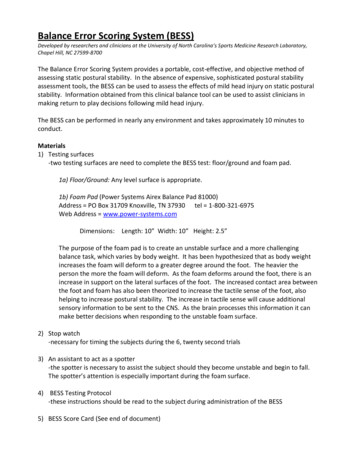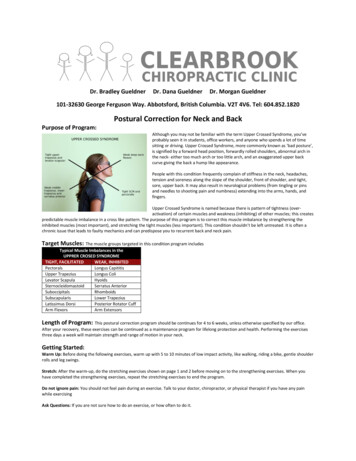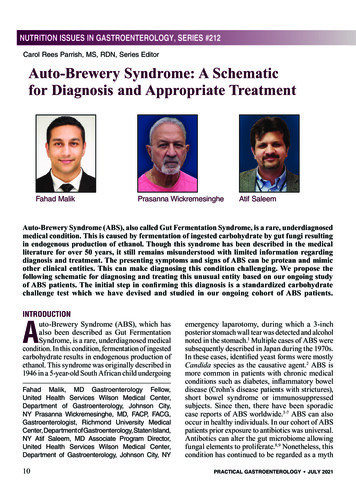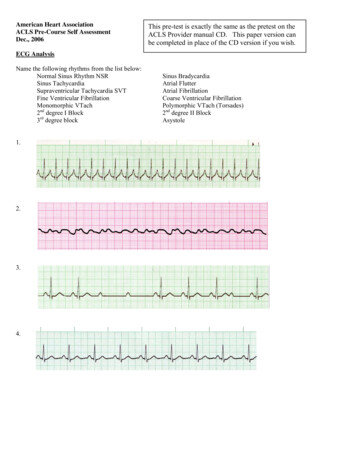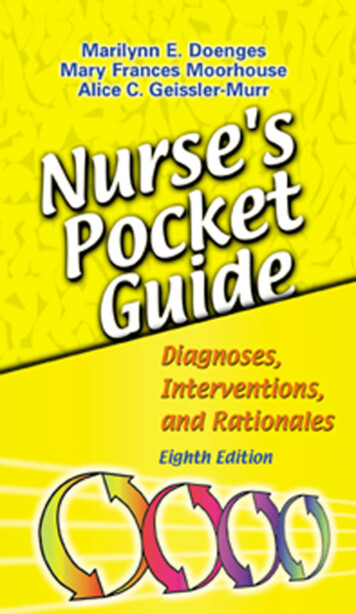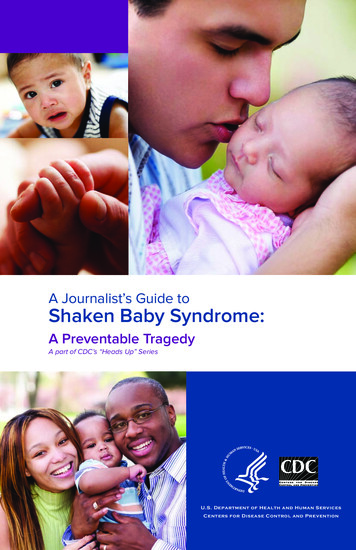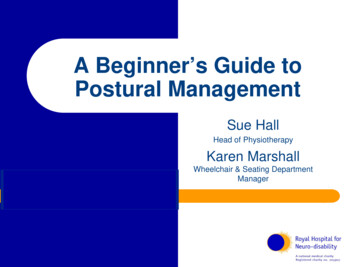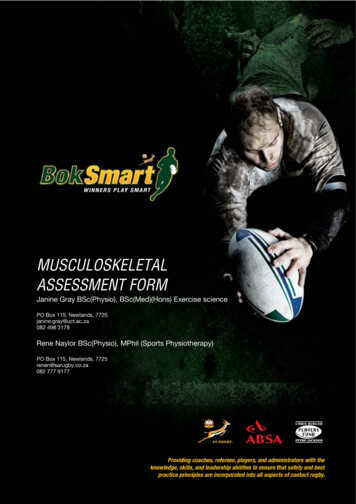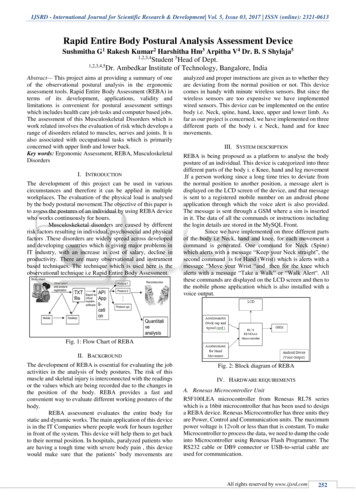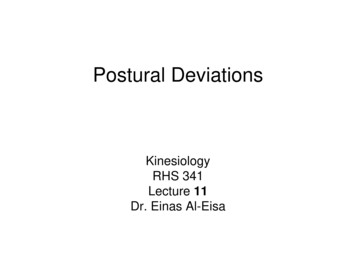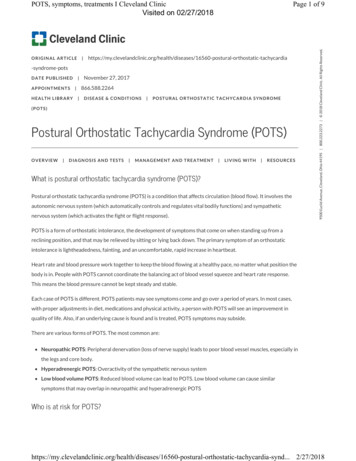
Transcription
POTS, symptoms, treatments I Cleveland ClinicPage 1 of 9Visited on 02/27/2018OR IGI NAL A RT IC LE ATE PUBL ISHE DAPPOI NTME NTSHEA LTH LI BRARY November 27, 2017866.588.2264 DISE ASE & C ON DITI ON S POST URA L O R THO S TA TIC TA CH YC ARDI A SY NDRO ME(P O TS )Postural Orthostatic Tachycardia Syndrome (POTS)OV ER VI EW DIA GNO SI S A ND T ESTS MA NAG EMENT A ND TRE ATME NT L IV ING WIT H RESO URC ESWhat is postural orthostatic tachycardia syndrome (POTS)?Postural orthostatic tachycardia syndrome (POTS) is a condition that affects circulation (blood flow). It involves theautonomic nervous system (which automatically controls and regulates vital bodily functions) and sympatheticnervous system (which activates the fight or flight response).POTS is a form of orthostatic intolerance, the development of symptoms that come on when standing up from areclining position, and that may be relieved by sitting or lying back down. The primary symptom of an orthostaticintolerance is lightheadedness, fainting, and an uncomfortable, rapid increase in heartbeat.Heart rate and blood pressure work together to keep the blood flowing at a healthy pace, no matter what position thebody is in. People with POTS cannot coordinate the balancing act of blood vessel squeeze and heart rate response.This means the blood pressure cannot be kept steady and stable.Each case of POTS is different. POTS patients may see symptoms come and go over a period of years. In most cases,with proper adjustments in diet, medications and physical activity, a person with POTS will see an improvement inquality of life. Also, if an underlying cause is found and is treated, POTS symptoms may subside.There are various forms of POTS. The most common are: Neuropathic POTS: Peripheral denervation (loss of nerve supply) leads to poor blood vessel muscles, especially inthe legs and core body. Hyperadrenergic POTS: Overactivity of the sympathetic nervous system Low blood volume POTS: Reduced blood volume can lead to POTS. Low blood volume can cause similarsymptoms that may overlap in neuropathic and hyperadrenergic POTSWho is at risk for s/16560-postural-orthostatic-tachycardia-synd. 2/27/2018
POTS, symptoms, treatments I Cleveland ClinicVisited on 02/27/2018Page 2 of 9The majority of POTS patients are women ages 13-50 years old. About 450,000 people suffer from POTS in theUnited States. Patients may develop POTS after a viral illness, serious infections, medical illness, pregnancy, and trauma such ashead injury. The condition may develop as aftermath of a significant illness (especially associated withhospitalization and prolonged immobilization). POTS may develop in those who have had a recent history of mononucleosis. People with certain autoimmune conditions such as Sjogren’s syndrome and celiac disease can be at higher risk.Sjogren’s can be evaluated by blood testing, dry eye test, lip biopsy, and rheumatology consult. Celiac disease canbe tested through blood work, gastroenterology consult, and if needed biopsies of the small intestinesWhat are the symptoms of postural orthostatic tachycardia syndrome (POTS)?POTS symptoms can be uncomfortable and frightening experiences. Patients with POTS usually suffer from two ormore of the many symptoms listed below. Not all patients with POTS will have all these symptoms. High/low blood pressure High/low heart rate; racing heart rate Chest pain Dizziness/lightheadedness especially in standing up, prolonged standing in one position, or long walks Fainting or near-fainting Exhaustion/fatigue Abdominal pain and bloating, nausea Temperature deregulation (hot or cold) Nervous, jittery feeling Forgetfulness and trouble focusing (brain fog) Blurred vision Headaches and body pain/aches (may feel flu-like); neck pain Insomnia and frequent awakenings from sleep, chest pain and racing heart rate during sleep, excessive sweating Shakiness/tremors especially with adrenaline surges Discoloration of feet and hands Exercise intolerance Excessive or lack of sweating Diarrhea and/or constipationDiagnosis and TestsHow is postural orthostatic tachycardia syndrome (POTS) . 2/27/2018
POTS, symptoms, treatments I Cleveland ClinicVisited on 02/27/2018Page 3 of 9POTS can be difficult to diagnose due to so many symptoms occurring in the body over time. Before diagnosis ofPOTS, various symptoms may lead patients to try many doctors. Patients with POTS may have symptoms for monthsto years before finally being diagnosed with the condition.A tilt table test is the gold standard of POTS diagnosis. The tilt table measures your heart rate and blood pressure asyou change posture and position.Besides the tilt table, other testing may be done for POTS: Blood and urine test for causes of POTS and conditions that mimic POTS QSART (a test that measures the autonomic nerves that control sweating) Autonomic breathing test (to measure how your blood rate and pressure respond during exercise) TST (tuberculin skin test) Skin nerve biopsy Echocardiogram Blood volume with hemodynamic studiesManagement and TreatmentHow is postural orthostatic tachycardia syndrome (POTS) treated? Medications like salt tablets, fludrocortisone, pyridostigmine, midodrine, and or a beta blocker may be prescribedto help control POTS. You may be prescribed thigh-high medical compression stockings. These stockings help push the blood up fromthe legs to reduce POTS symptoms You should obtain a blood pressure monitor to check blood pressure and pulse. Blood pressure monitors may bepurchased at most drug stores, online, or at a medical supply store. Have your blood pressure monitor checked atyour doctor’s office to make sure your machine’s readings correlate with your doctor’s blood pressure readings Although the heart is healthy in most POTS patients, you may be evaluated to enter a cardiac rehab program.This exercise template uses the cardiac rehab model to recondition and help improve health and control POTS.Some of the best data for treating POTS comes from cardiac rehabWhat are everyday ways to help manage POTS?Diet and nutrition Increase sodium in your diet to 3,000 mg to 10,000 mg per day. Drink 2-2.5 liters per day of fluids. Water is a good choice. Sports drinks may be used, but watch calories and ifyou have food sensitivities to these drinks’ ingredients Small and frequent meals are better tolerated and reduce POTS eases/16560-postural-orthostatic-tachycardia-synd. 2/27/2018
POTS, symptoms, treatments I Cleveland ClinicVisited on 02/27/2018Page 4 of 9 Diet with high fiber and complex carbohydrates may help reduce blood glucose (sugar) spikes and lessen POTSsymptoms. Keep your nutrition balanced with protein, vegetables, dairy, and fruits. Plan meals as POTS patients may occasionally not have stamina for grocery shopping and preparing meals. Planmeals when your energy is at its peak. If possible, make it a family plan to prepare food and share groceryshopping responsibilities. Don’t over-rely on processed foods. Processed foods are easy to prepare and are appealing when one hasreduced energy, but usually have less nutritional value Beneficial salty snacks may include chicken or beef broth, vegetable broth, pickles, olives, salted fish likesardines/anchovies, and nuts. Don’t over-rely on snack chips and crackers for salt Plan grocery store shopping by having a list to make sure healthy food choices and POTS care (hydration andsalty supplements). If your stamina is reduced have someone help you shop, carry, and put away your groceries Health conditions can be costly. Do your best not to compromise nutrition and food choices to save money You may need a dietary and nutrition consult ordered by your doctor to help you with your diet. This consult canbe especially helpful for those with celiac and other dietary sensitivities Often in early phase of POTS patients do not like how their bodies feel and look. Be careful of fad diets or dietsupplements for weight lossMonitoring POTSTaking and writing down your vital information (blood pressure and pulse) can give you insight and better controlover your POTS, and helps your doctor fine tune your treatment.Check blood pressure and pulse at the same time daily (in the morning and after dinner). It’s very helpful to do this forthe first few months of your diagnosis. Also check blood pressure and pulse when you are not feeling well.Heart rate/pulseMeasuring heart rate can give you insight as you deal with POTS. Other facts about heart rate and POTS: A normal heart rate is between 60 to 100 beats per minute. A fast heart rate over 100 beats per minute can be a condition called tachycardia. A slow heart rate under 60 beats per minute is called bradycardia. High or low rates can cause symptoms of POTS.Blood pressureBlood pressure is the pressure of the blood in the blood vessels in the circulatory system. Blood pressure is related tothe heart beating and the diameter and elasticity of the artery es/16560-postural-orthostatic-tachycardia-synd. 2/27/2018
POTS, symptoms, treatments I Cleveland ClinicVisited on 02/27/2018Page 5 of 9 Blood pressure has two components, systolic and diastolic. Blood pressure is recorded as systolic/diastolic. Forexample, a blood pressure reading of 120/80 represents the systolic being the 120 number and the diastolic beingthe 80 number The systolic refers to the amount of pressure in the arteries during the contraction of your heart muscles (heartbeats). The diastolic refers to the blood pressure between heart beats Normal blood pressure is between is 90-120 for systolic and 60-80 for diastolic. Many patients will have stable blood pressure readings since the adrenergic response to keep heart rateincreased will reduce blood pressure drops. POTS patients can have moments of hypertension with the systolic over 140 or diastolic over 85. If hypertensionoccurs in many readings, inform your POTS specialist of these consistent readings of hypertension Low blood pressure is below 90/60. Blood pressure logging that reveal low blood pressure readings can be helpfulfor POTS treatmentExercise and physical activityExercise and physical activity are key to managing POTS. Here are important things to know as you undergo anexercise program such as cardiac rehab, as well as other physical activities. Talk with your healthcare provider forspecific instructions on these exercises. Isometric exercises involve contracting your muscles without actually moving your body. Isometrics squeeze themuscle and push the blood back toward the heart. They are simple to do and can be done lying in bed or seated ina comfortable chair. It is a good idea to do these in bed before getting up to prepare your body for sitting andstanding Transition slowly with your body. Go from lying to sitting on the edge of the bed. Stay there for several minutes,allowing the body to naturally adjust to the change in position. Once you are standing, pause and wait beforewalking to allow blood pressure to adjust again. If you feel lightheaded at any point, wait for a few minutes in thatposition to see if it resolves. If not, then return to the prior position as your body is not adjusting properly.SLOWLY is the key Begin a modest walking program. Count how many steps you can do without inducing symptoms. These steps areyour initial baseline. Start with walking once a day and go a little further in time, distance, or by adding steps. Ifyou feel good, add a second walk in the day. A simple strategy for counting steps is to do 100- 300 steps perawakening hour during the day. Fitness trackers can monitor steps and distance easily. Every week or every fewweeks add more steps to your daily total Simple yoga with focusing on breathing may help reduce POTS symptoms.As you do better with your POTS, more fitness and exercise regimens may be ynd. 2/27/2018
POTS, symptoms, treatments I Cleveland ClinicVisited on 02/27/2018Page 6 of 9 Try to maintain a typical sleep schedule. Go to bed consistently at a certain time and set a consistent time to wakeup. The best sleep hygiene and good rest comes from staying consistent with your sleep schedule every day. Evenif you had a poor night of sleep, try to get up at your regular time. A consistent sleep schedule, even with a badnight’s sleep, helps you feel better in the long term Excessive daytime napping may make nighttime sleep less restful. Most people need 7 to 10 hours sleep at night. Be aware of POTS symptoms of chest pain, sweating, restlessness, and racing heart rate during bedtime. Thesesymptoms interfere with sleep quality and may have to be addressed by your POTS specialist Avoid excessive television viewing or use of tablet/smartphone/computer in bed. These technologies caninterfere with sleep quality Raise the head of your bed 6-10 inches to help alleviate POTS symptoms. The entire bed must be at an angle.Raising the head of the bed will reduce urine formation overnight and increase fluid volume in your circulation inthe morning. This may help you wake up more easily Make sure the temperature is ideal in your bedroom to help you get proper rest.Living WithHow do I coordinate and organize my care with postural orthostatic tachycardia syndrome(POTS)? Start a binder or folder containing your basic notes and testing results. Periodically review this binder to removeout-of-date data. As a rule, about 20-30 pages of pertinent medical data will help guide your POTS medical teammost effectively You will need a healthcare provider or primary care physician to go to for routine care and health wellnessmanagement. Your POTS specialist may ask you to see your healthcare provider periodically. Get copies of yourmedical visit notes from your healthcare provider — especially any additional testing results — to have in yourrecord binder (see above) If you are feeling very ill or something doesn’t feel right, you may need to go to the ER or Urgent Careimmediately. If you call your POTS specialist or send a My Chart message (see below) you may be told to go to theER or Urgent Care Signing up for Cleveland Clinic’s My Chart will make your care more efficient. You can access test results andmedical records, reach out to your medical provider, and schedule tests and appointments When sending a My Chart message please re-read your message to make sure your note is clear and concise.A short, to-the-point message sent to your medical team will deliver the best results for you When receiving a message from your medical team, please read very carefully to make sure you understandthe message. At times you should print the message if there is key information or new guidance regarding your care. Themessage may have information you need to remember and use in the es/16560-postural-orthostatic-tachycardia-synd. 2/27/2018
POTS, symptoms, treatments I Cleveland ClinicVisited on 02/27/2018Page 7 of 9 Be sure to check this manual since it may have solutions that help you. The manual may also help you organizemore effective questions to your medical team during an appointment and with phone calls and My Chartmessages. We recommend you review this manual weekly in the first few months of your POTS diagnosis Look into shared medical appointments for POTS. The Cleveland Clinic offers medical appointments for POTSpatients where 8-15 patients come together for a 90-minute medical appointment. You can get education on yourPOTS and the group can work together to help troubleshoot problems Be sure to follow up with your POTS specialist.How do I cope emotionally with POTS? Be open and honest with loved ones and support groups about your diagnosis of POTS. Talk about your fears,hopes, struggles, and challenges with the condition. Encourage the people who support you to read this manual tolearn more about POTS Get enough sleep and eat well to help manage stress. Shared medical appointments and POTS support groups (either online or in person) will help reduce the feeling ofbeing alone and different. Be careful with social media. Be mindful of the accuracy of any particular website’s data. Some POTS patients findcomfort in social media. For others, social media can cause unnecessary and excessive stress and worry Be very cautious of quick solutions from non-medical sources and people. Quick solutions usually don’t helpPOTS and can even cause more emotional distress Be aware that with many neurological diseases like POTS, patients can look well. Don’t be stressed if someonesays “you don’t look sick” or “you look good.” Take this as a compliment that you still look good despite having ahealth condition We recommend counseling to help you learn to cope with a chronic health condition. Counseling may help tocontrol other co-existing mental health issues that may negatively influence POTS Meditate or take even just a few minutes of a time-out to help reduce some of your POTS symptoms. Emotions can have a significant influence on your daily life and health. Identifying them can be useful if you aretalking with a counselor or POTS support group. Think if the following emotions are present in your thoughts: FRUSTRATION: distress and annoyance, especially in the inability to change or achieve something ANGER: feeling of displeasure and annoyance GRIEF: deep sorrow over a loss DISAPPOINTMENT: sadness and displeasure over failure or lack of fulfillment of one’s hopes, expectations,and goals GUILT and SHAME: painful feeling of humiliation or distress from perceiving you have done somethingwrong EMBARRASSMENT: feeling of shame and awkwardness CATASTROPHIZE: a perception or feeling that something is worse than it really is HOPE: Feeling of an expectation and desire for a positive thing to happen TRUST: belief in the reliability, truth, accuracy, and ability of something, concept, or a es/16560-postural-orthostatic-tachycardia-synd. 2/27/2018
POTS, symptoms, treatments I Cleveland ClinicVisited on 02/27/2018Page 8 of 9ResourcesInformation on postural orthostatic tachycardia syndrome (POTS) for your healthcareproviderDear Colleague,Your patient has been diagnosed with postural orthostatic tachycardia syndrome (POTS). This is a form ofdsyautonomia prone to orthostasis.Common symptoms are syncope, near syncope, postural dizziness and light-headedness, tachycardia, and low bloodpressure. The patient may at times have hypertension, headaches, body pain, and some brain fog.POTS can be seen commonly in aftermath of acute or chronic illness, post mononucleosis, small fiber neuropathy,Sjogren’s syndrome, head injury, or be idiopathic. POTS may be seen more infrequently with Marfan syndrome, EhlerDanlos, and mast cell activation.Treatments we use include salt and oral hydration and medications like fludrocortisone, midodrine, beta blockers, salttablets, and pyridostigmine. We also use cardiac rehab, which has some of the most promising long-term data forreduction of POTS symptoms. Along with routine care, we offer shared medical appointments to our establishedPOTS patients to educate the patient and family on the condition.Since POTS can cause diverse symptoms, here are some tips to help you when you see the patient:1.Vitals in the office — especially orthostatic vitals — can be helpful to document low blood pressure, tachycardia,or even some hypertensive surges. If tachycardia is persistent, then adding or adjusting the beta blocker may behelpful and done in the office. If there are hypertensive surges, increasing beta blocker or use of a calciumchannel blocker an ARB may help. If blood pressure readings are low increasing the POTS medication can behelpful. With a copy of the vitals and the office note, the patient can reach out to us for more guidance formedication adjustment and other therapeutics2.Doing basic medical evaluation is appreciated since these patients may have routine medical problems and morehealth consequences of immobilization (in extreme cases of immobilization we may see DVT, PE, UTI, andpneumonia).3.Checking routine blood and urine testing of UA, urine culture, BMP, CBC, and TSH can be helpful.4.Encourage the patient to do the autonomic care we have recommended such as the cardiac rehab, follow-up atshared medical appointments, vitals logging at home, maintaining salt oral intake of 3-5 grams per day, oralhydration, and wearing compression stockings.5.If clinical concerns are present, we recommend sending the patient to the ER.6.Please fax any office note or give a copy of the office note to the patient to share with the POTS doctor.7.Most health issues do cause stress and angst. We recommend counseling at times to help patients cope withthese issues. If needed, SSRIs and SSNRIs are tolerated well by these patientsThe majority of the POTS patients will do well over time, especially with diligence to their POTS s/16560-postural-orthostatic-tachycardia-synd. 2/27/2018
POTS, symptoms, treatments I Cleveland ClinicVisited on 02/27/2018Page 9 of 9Thank you for your teamwork with our shared patient.References: National Institutes of Health. NINDS POTS /NINDSPOTS.aspx) Accessed 6/2/2017. American Academy of Neurology. POTS (http://patients.aan.com/disorders/index.cfm?event view&disorder id 1044) Accessed 6/2/2017. Dysautonomia International. General Information Brochure on Orthostatic Intolerance and its Treatment OIsummary.pdf) Accessed 6/2/2017. Copyright 1995-2018 The Cleveland Clinic Foundation. All rights reserved.This information is provided by the Cleveland Clinic and is not intended to replace the medical advice of your doctor orhealthcare provider. Please consult your healthcare provider for advice about a specific medical condition. This documentwas last reviewed on: . 2/27/2018
Diet and nutrition Increase sodium in your diet to 3,000 mg to 10,000 mg per day. Drink 2-2.5 liters per day of fluids. Water is a good choice. Sports drinks may be used, but watch calories and if you have food sensitivities to these drinks’ ingredients Small and freq
